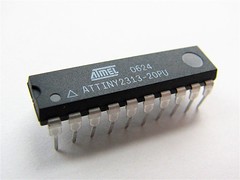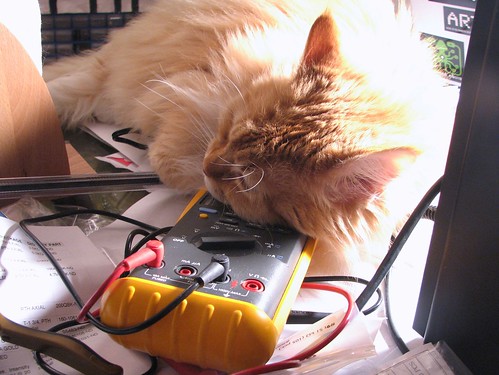All posts by Windell Oskay
A Dip Chip Bristlebot

What can you do with a busted (or merely obsolete) chip? Well, you can always make a trivet or even chip bugs. But here’s a new one: Alejandro Gonzalez found that you could make a BristleBot by bending the pins of the
chip. Clever!
[Flickr photo set]
[YouTube video — blurry but you get the idea.]
Reminder: Microcontroller classes this week at TechShop
Tomorrow (Monday 3/3/08) at TechShop in Menlo Park, CA, I’m giving another AVR intro class. These classes have been big, lively, engaging and interesting, with a lot of good questions– two sessions are scheduled this month:
Monday, 3/3/08, 6:30-8:30 PM, and
Saturday, 3/22/08, 1:00-3:00 PM
Seminar: Introduction to AVR Microcontrollers
AVR microcontrollers are powerful and versatile single-chip computers that cost only a few dollars each. You may have noticed that a number of our interesting projects are based around these, using them to make smart little toys and machines.
This class is aptly billed by TechShop as “How To Use AVR Microcontrollers in Your Projects.” Indeed. We’ll be bringing along a number of our cool AVR-based Evil Mad Scientist Laboratories projects from to show off some of the things that you can do with these little marvels, and how you might go about doing it.
Formal class description: “AVR microcontrollers are powerful, versatile and inexpensive single-chip computers that are remarkably easy to program in C, using entirely free and open-source tools that run on Macs, Windows, and Unix-like operating systems. In this practical introduction to AVR microcontrollers, we’ll take it from the beginning so that you can get started using them for your own cool projects. Some topics to be covered include: different types of AVRs and how to pick one for your application, getting a programmer, installing software tools, how to get started actually programming them, and how to download and run your code on the microcontroller. Class format is a one hour lecture followed by show-and-tell demonstrations and ample time for questions.”
Sign up here.


Seats are still available in one other microcontroller project class:
Soldering Project: Build a Micro Readerboard
A fun little soldering class, where you can customize the phrases in and build your very own LED Micro-Readerboard. It’s a cute little toy that spells out a preprogrammed messages (e.g., your name– for an LED nametag!), one letter at a time, on its display. In the class, you get to choose what messages to put on your readerboard, solder it together and take it home. It’s a neat, self-contained project that’s a great example of what you can do with a little AVR microcontroller; a perfect “my first microcontroller” project for anyone who hasn’t played with one yet. This is an intermediate soldering class; some prior soldering experience is needed. Other than that, no prior knowledge is assumed, so this class is great for kids too.
Next Classes:
- Saturday, 3/8/08, 1:00 PM
- Saturday, 3/22/08, 4:00 PM
Sign up here!
The nature of the beast
Planning Peggy Projects
Building a Peggy of your own? This neat Peggy planner by Mike Biel might come in handy.
Peeking in on some LEDs
I took some close-up pictures of LEDs to get a look at what’s inside. These are just standard T-1 3/4 (5 mm) package superbright LEDs with clear lenses, one of the most common types, and I took the photos by placing my the lens of my camera (Canon S3 IS) right up to them.
Continue reading Peeking in on some LEDs
Melt my heart.
Linkdump: February 2008
- Mickey Mouse Logic is darn useful.
- Gag gift for a cat owner
- Xylocopa Design: especially the anglerfish earrings.
- The Zero Dollar Homepage
- Mini Yip Yip
- Valentine on a Peggy.
- I love Fred products. Check out the packaging on this one.
- low-voltage fuorescent driver
- Pac Snacks
- Magnet curtains
- Cute AVR ISP to breadboard adapter PCB. [via]
- High-voltage cake
- Research LOLcats
- SpriteStitch
LOLtronics: invisible printed circuit board

Adapted from the original by John Shadle, and used by kind permission. (Thanks!)
“Peggy,” A Light Emitting Pegboard Display
With all the cool things that you can do with LEDs today, there is still one thing that’s lacking: simplicity. If you want to run a bunch of LEDs at a time, you usually end up spending a fair bit of time worrying about series and parallel combinations, matching brightness, and picking load resistors. Or, if you’re a beginner, maybe you only get one third of the way through the previous sentence– wondering if you’re already in over your head.
Suppose that you want to make a big LED display for your window or wall: maybe it’s your logo, a symbol, your favorite 8-bit character, or maybe even a sign that spells out words like “OPEN” or “ON AIR.” How do you go about it? The usual DIY solution involves drilling holes in a panel to fit your LEDs, then spending a heck of a lot of time wiring everything up– ending up with one resistor per LED (and a three-dimensional mess if you happen to look at the back side of the panel). And, if you do everything in the most obvious ways, it can even end up consuming a surprising amount of power.
While I have certainly spent my share of time constructing things with the aforementioned technique, at some point it becomes clear that there has to be a better way. In this day and age, shouldn’t LEDs be about as difficult to play with as, say, a Lite Bright? Today we are releasing a new open-source hardware and software design that takes some of the sting, complexity, and mess out of playing with LEDs. It’s a versatile and powerful light-emitting pegboard that lets you efficiently drive hundreds of LEDs in whatever configuration you like, without so much as calculating a single load resistor.
Continue reading “Peggy,” A Light Emitting Pegboard Display










